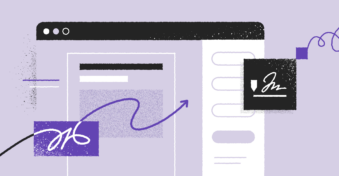As a property owner, minimizing the potential liability you and your business may face is an absolute must. One of the best ways to do that is to create a property liability waiver that visitors sign when they arrive. Knowing how to create a property liability waiver is crucial to getting it right.
Property liability waivers protect property owners from real or potential liability against claims of injury, death, or other damages. They can include clauses like voluntary assumption of risk, provisions that prevent the signatory from suing the property owner, and a clear description of the potential risks involved.
Below, we’ll walk you through the steps to write a property liability waiver.
How to Write Up a Property Liability Waiver?
While it’s generally advised that you use a liability waiver template, consult an attorney, or use software like PandaDoc Waivers, writing up your own property liability waivers is possible.
That said, it’s essential you follow the proper formatting rules and include all the necessary information if you do decide to create your own property liability waiver. Failure to do so could leave your waiver agreement unenforceable, opening you up to potential liabilities in court.
Here are 10 easy steps to creating your own property liability waiver.
Step 1: Use the right formatting
Before starting, set your font to Times New Roman and font size to 12 to ensure that all the information in the property liability waiver is clear and readable. You should also bold or capitalize key points and use bullet lists, where applicable.
Some lawyers use a font size of 14 to help with readability, so feel free to use larger text. However, it’s worth noting that any text written in a font size of 11 or smaller may compromise the enforceability of your property liability waiver.
Step 2: Add the title
Your waiver won’t be valid without a title, so be sure to center the “Property Release of Liability Waiver” text between the margins of your document formatted as a heading in bold.
Step 3: Describe the risks
Create a clear and exhaustive list of all the potential risks that the Releasor (party relinquishing rights) may face while engaging in an activity organized by the Releasee (the party being relieved of liability.) Use simple language and ensure that your representation of the risks covers current and future risks; otherwise, a court may not find your liability waiver valid.
Make sure you don’t mix the Releasor-Releasee terminology up in this (or any other) section of the waiver. An example that can help you remember is that a Releasor could be a customer of a rock climbing gym while the Releasee would be the gym owner.

Step 4: Waiver coverage
It’s important to list the injuries and damages for which your waiver will be effective. You can consult with other business owners to create a list of the most likely injuries that visitors may face.
Injury and death are the most common inclusions, but it’s important to note the exceptions in which the written coverage of your waiver won’t protect you from liability. This includes cases of gross negligence or scenarios where the business had a legal obligation to make the activity safe (such as construction site injuries, for example).
Step 5: Insurance coverage
Your property liability waiver should clearly state that you will not be providing insurance coverage to the Releasor in the event that they are injured or killed. You should also list all liability policy language in this section.
Step 6: Assumption of risk clause
A key clause to include in your liability waiver is the voluntary assumption of risk. This will clearly state that the Releasor is aware of the potential risks they may face, accepts them, and voluntarily relinquishes their right to sue you for those items your waiver covers.
Step 7: Choice-of-law clause
A choice-of-law clause states the venue and forum of laws recognized in your release of liability waiver. This is a useful clause to have as the Releasor(s) may live in a different jurisdiction, which would otherwise lead to ambiguity regarding what regulations apply.
Step 8: Confirmation
Your waiver should include a confirmation section stating that the Releasor has read the release of liability agreement in its entirety and fully understands what the waiver entails.
This is often placed directly above the signature field to ensure that the Releasor sees it before signing the waiver. Confirmation sections may seem superfluous, but they can help your property liability waiver be upheld in court.
Step 9: Signatory information
It’s crucial that your property liability waiver includes the names, addresses, and contact information of all the parties in the agreement — both the Releasor(s) and the Releasee.
Step 10: Date and signature
Finally, add the date on your liability waiver and ensure that your document has a legally binding signature. Including the date on liability waivers ensures their validity and is the best way to prove that the waiver was signed before the injury occurred.
Under the guidelines established by the UETA and ESIGN acts, electronic signatures are equally binding to that of a handwritten signature when it comes to liability waivers.
Final Thoughts
As you can see, property liability waivers are a great way to protect you from liability, but only when they are written correctly. Be sure to stick to the guidelines this article provides and consult with a licensed attorney if you have any questions throughout the process.
If you need to create a legally binding property liability waiver, you can use PandaDoc Waivers. With our easy-to-use solution, you’ll be able to create digital waivers in a matter of minutes.
Our waiver software is quick to set up, lets you view every active waiver on a single dashboard, and secures all your documents with UETA and ESIGN-compliant electronic signatures.
Get Your Digital Waiver Solution now!


